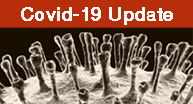Novel Coronavirus (SARS-CoV-2) resistance in African populations: A cause worth exploring
Novel coronavirus resistance in African population
Keywords:
SARS-CoV-2; Disease immunity; Africans; Natural selectionAbstract
The pandemic caused by Novel Coronavirus SARS-CoV-2 shows its devastating effects all over the world. The American and the European countries are the worst-hit by this COVID-19 pandemic. However, most of the African countries excepting a few are less affected by this virus as far as the number of cases and deaths are concerned. The correspondence proposes that just like the abnormal haemoglobins HbS and HbC are found to provide immunity to the African populations against infectious diseases such as Plasmodium falciparum malaria The possibility of these abnormal haemoglobins offering certain protection against the Novel Coronavirus infection in these populations needs to be explored.
References
References:
Worldometer of COVID-19 Coronavirus pandemic, Available at: https://www.worldometers.info/coronavirus/ (Accessed on 19th May 2020).
Achan, J., Talisuna, A.O., Erhart, A. et al. Quinine, an old anti-malarial drug in a modern world: role in the treatment of malaria. Malar J 10, 144 (2011). https://doi.org/10.1186/1475-2875-10-144.
Colyer J. An update on the coronavirus treatment-Hydroxychloroquine and azithromycin continue to show results for patients. WSJ, March 29, 2020, Available at: https://www.wsj.com/articles/an-update-on-the-coronavirus-treatment-11585509827 (Accessed on 17th May 2020).
Wang M, Cao R, Zhang L, Yang X, Liu J, Xu M, Shi Z, Hu Z, Zhong W, Xiao G. Remdesivir and chloroquine effectively inhibit the recently emerged novel coronavirus (2019-nCoV) in vitro. Cell Res. 2020 Mar;30(3):269-271.
Colson P, Rolain JM, Lagier JC, Brouqui P, Raoult D. Chloroquine and hydroxychloroquine as available weapons to fight COVID-19. Int J Antimicrob Agents. 2020 Mar 4:105932. doi: 10.1016/j.ijantimicag.2020.105932.
Yao X, Ye F, Zhang M, Cui C, Huang B, Niu P, Liu X, Zhao L, Dong E, Song C, Zhan S, Lu R, Li H, Tan W, Liu D. In Vitro Antiviral Activity and Projection of Optimized Dosing Design of Hydroxychloroquine for the Treatment of Severe Acute Respiratory Syndrome Coronavirus 2 (SARS-CoV-2). Clin Infect Dis. 2020 Mar 9. pii: ciaa237. doi: 10.1093/cid/ciaa237.
Allison, A.C. Protection afforded by Sickle-cell trait againt Subaltern malarial infection, Br. Med. J. 1954, 1, 290–294.
Luzzatto L. Sickle cell anaemia and malaria. Mediterr J Hematol Infect Dis. 2012;4(1):e2012065. doi:10.4084/MJHID.2012.065.
Elguero E, Délicat-Loembet LM, Rougeron V, et al. Malaria continues to select for sickle cell trait in Central Africa. Proc Natl Acad Sci USA. 2015;112(22):7051–7054. doi:10.1073/pnas.1505665112.
Sabeti, P. (2008) Natural selection: uncovering mechanisms of evolutionary adaptation to infectious disease. Nature Education 1(1):13. Available at: https://www.nature.com/scitable/topicpage/natural-selection-uncovering-mechanisms-of-evolutionary-adaptation-34539/ (Accessed on 17th May 2020).
Fairhurst RM, Baruch DI, Brittain NJ, et al. Abnormal display of PfEMP‐1 on erythrocytes carrying haemoglobin C may protect against malaria. Nature. 2005;435:1117‐1121

Downloads
Published
Issue
Section
License
This is an Open Access article distributed under the terms of the Creative Commons Attribution License (https://creativecommons.org/licenses/by-nc/4.0) which permits unrestricted use, distribution, and reproduction in any medium, provided the original work is properly cited.
Transfer of Copyright and Permission to Reproduce Parts of Published Papers.
Authors retain the copyright for their published work. No formal permission will be required to reproduce parts (tables or illustrations) of published papers, provided the source is quoted appropriately and reproduction has no commercial intent. Reproductions with commercial intent will require written permission and payment of royalties.






